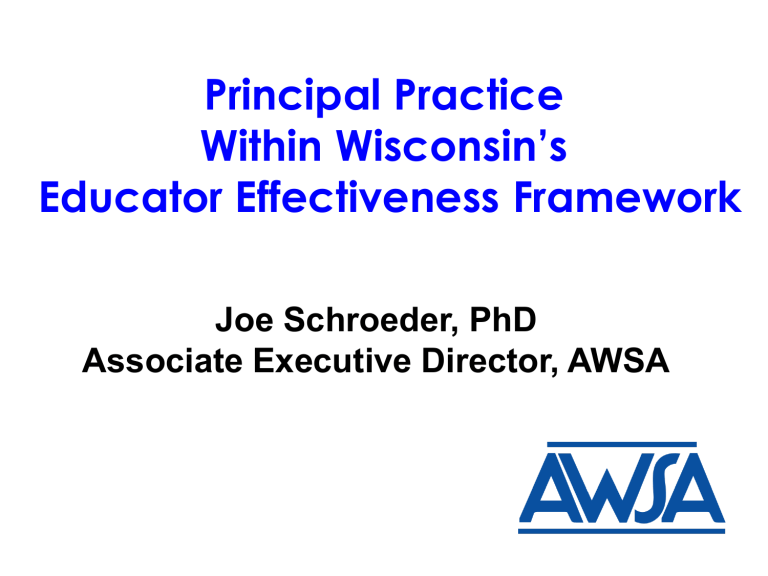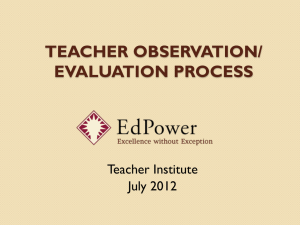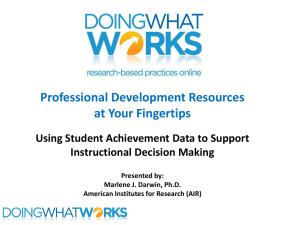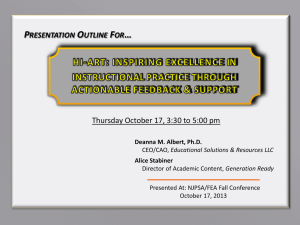Principal Practice within Wisconsin`s Educator Effectiveness

Principal Practice
Within Wisconsin’s
Educator Effectiveness Framework
Joe Schroeder, PhD
Associate Executive Director, AWSA
Session Learning Targets
I) Gain familiarity with Wisconsin’s developing principal practice rubric
II) Identify sources of evidence for various components of principal practice
III) Identify key considerations and initial steps for moving forward in the new era
Why the Focus on Principal
Effectiveness?
Although many factors contribute to student learning, leadership is the second most powerful school-level factor in student learning.
(Hallinger & Heck, 1996; Horng, Klasick, & Loeb, 2010)
Why the Focus on Principal
Effectiveness?
Strong school leadership is essential for
Cultivating high-performing schools
Attracting and retaining high-quality teaching staff
Building community support for education efforts
(Clifford, Behrstock-Sherratt, & Fetters, 2012)
Why the Emphasis on Evaluating
Principal Practice?
• Evaluation practices vary greatly across schools and districts
• Professional standards (such ISSLC and/or state standards) often not aligned with evaluation practices
• Little empirical evidence that current evaluation models and instruments are effective or technically sound
(WestEd, 2011)
Why the Emphasis on Evaluating
Principal Practice?
The professional literature highlights the importance of principal evaluation in changing practice from the historical emphasis on managerial responsibilities to more recent expectations that
principals are instructional leaders, who are responsible and accountable for student learning.
(WestEd, 2011)
Principal Practice Part I:
Familiarity with Wisconsin’s
Principal Effectiveness Framework & Rubric
ISLLC Standards
(Interstate School Leaders
Licensure Consortium)
1) Human Resource Leadership
2) Instructional Leadership
3) Personal Behavior
4) Intentional and Collaborative School Climate
5) School Management
Purposes for Professional Standards
• Provide a common language and understanding about effective principal practice
• Support professional growth through selfassessment, reflection and collaboration
• Link various sources of evidence to principal practice that result in improved student achievement
Take a Closer Look
What structure do you see?
Structure of Wisconsin’s
Principal Effectiveness Framework
2 Domains
5 Components
23 Elements
4-Point Rubric for Each Element
Domain 1: Teacher Effectiveness
Component 1.2 Instructional Leadership
1.2.1 Living a Vision and Mission for ALL Students
1.2.2 High Expectations for Academic Achievement
1.2.3 Classroom Observations and Feedback
1.2.4 Instructional Time
1.2.5 Teacher Collaborations
1.2.6 Data Usage in Teams
1.2.7 Rigorous Student Learning Objectives
4-Point Rubric for Each Element
Ineffective
Minimally Effective
Effective
Highly Effective
Effective Principal Practice at the Component Level
• Relationships to the ISSLC Standards
• Overall themes you notice
Reflection and Consolidation:
Session I
What priorities do you see needed as your district prepares for full implementation of principal practice supervision in coming months and years?
Principal Practice Part II:
Identifying Sources of Evidence
Evidence vs. Opinion
Evidence
Observable
Objective
Free of Value Judgment
Unambiguous
Opinion
Draws Conclusions
Subjective
Often Includes Value Judgment
Makes Inferences / Debatable
Potential Sources of Evidence
1.1 Human Resource Leadership
• School Improvement Plan
• Recruitment Methods
• Observations of Staff / Faculty
Potential Sources of Evidence
1.2 Instructional Leadership
• Memos, Newsletter, Website
• Samples of SLOs
• Team Meeting Agendas
Reflection and Discussion
1) Identify where we might look for evidence of the standard elements
2) Share your thoughts with a neighbor
Principal Practice Part III:
Moving Forward in the New Era
Foci for PD in the New Era
Understanding the relevant framework, evaluation process, and means for feedback
Foci for PD in the New Era
Identifying forms of rating bias, areas of common rating errors, and evidence sources most appropriate
Foci for PD in the New Era
Practice observing and rating evidence sources, with feedback, according to the relevant effectiveness framework.
Foci for PD in the New Era
Exploring how elements identified through the evaluation process can focus PD and support to enhance student learning in your school(s).
Foci for PD in the New Era
Practice coaching conversations as a tool for improving principal practice
Considerations / Next Steps
Diagnose
Develop
Intervene
Diagnose
Leadership and Learning Matrix
(Reeves, 2010)
Lucky:
• Good results with no understanding of the reasons
• Replication of success not probable
Leading:
• Good results with clear understanding of the reasons
• Replication very probable
Losing:
• Poor results with no understanding of the reasons
• Replication neither probable nor desirable
Learning:
• Poor results with clear understanding of the reasons
• Replication of mistakes not probable
Antecedents of Excellence
Develop
Intervene
Reflection and Consolidation:
Session II
What priorities do you see needed as your district prepares for full implementation of principal practice supervision in coming months and years?
joeschroeder@awsa.org
608.729.6656











